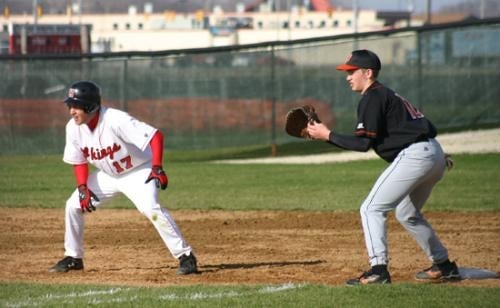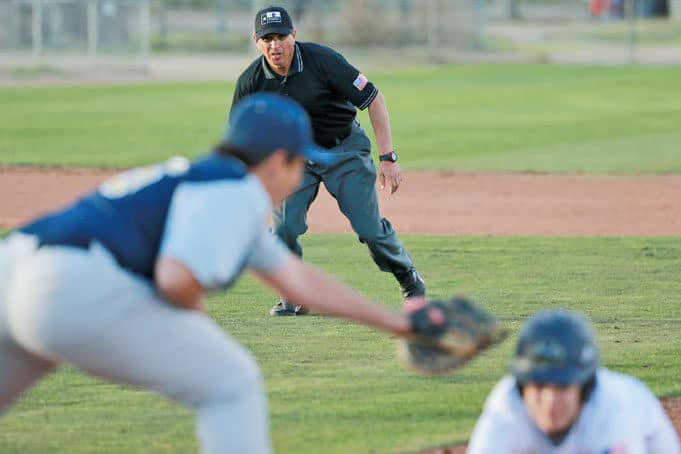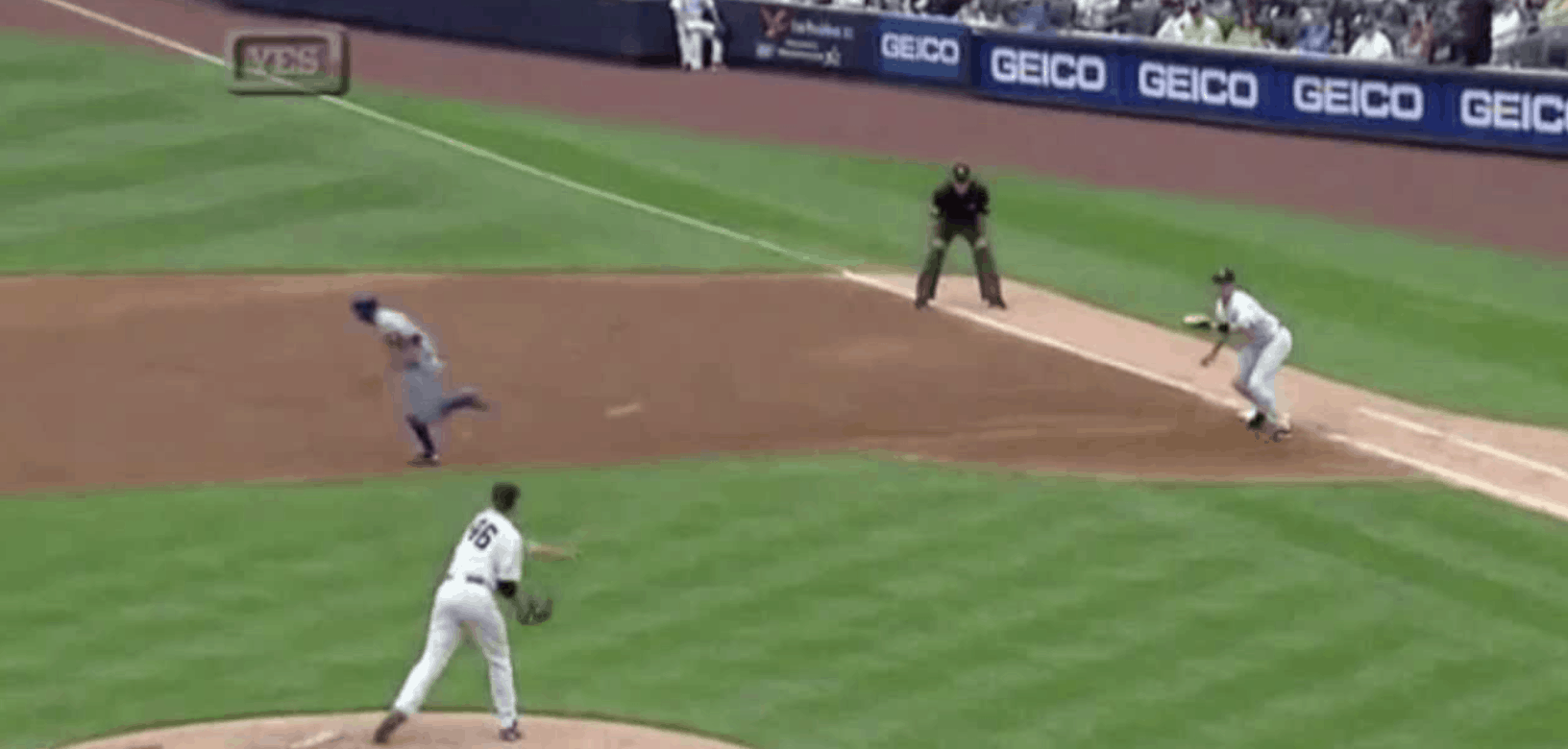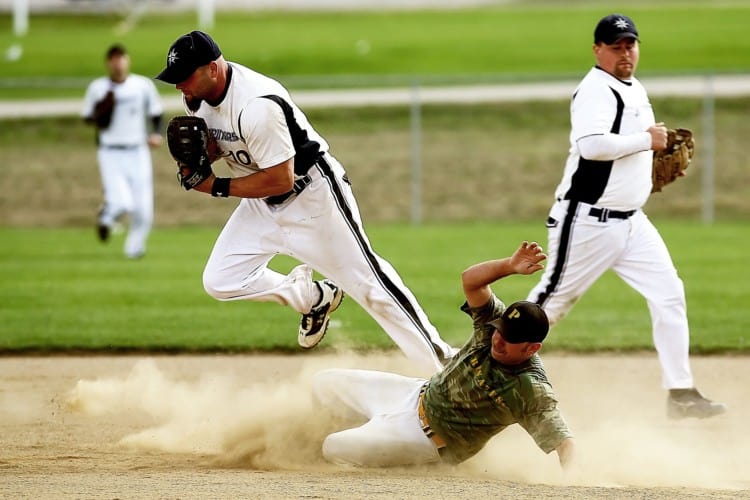Hitting, throwing and fielding are necessary skills for teams to have in order to win ball games. Youth teams who have the most wins have a well-developed practice regimen and excel at every facet of the game. This includes base stealing. What if you can make it so that your players can run and steal bases, and never get thrown out again?
Like drills for hitting, pitching and fielding, there are approaches to base stealing that, if implemented, help runners steal bases more easily. We’ve outlined below 12 tips for base stealing, so the odds of your players getting thrown out go way down, and your success rate surges upwards.
Leading Off of First Base
How far your base runner leads off first base in his attempt to steal can make the difference between a stolen base or and out. After reaching first, runners need to immediately establish eye contact with his coach, and watch for the steal sign.
Take a lead off the back corner of the base closest to right field. Looking down the base path, visualize a straight line to second. The lead your runners take is based on their height and their reflexes. Faster runners can lean farther away from the bag.
Taller players can take further leads than shorter ones, and the lead should always be just a step and a dive distance back to the first base bag.
Position of Feet When Leading Off First Base
Your player has either made a hit or took four pitches out of the strike zone and is now a runner on first base. You know he’s quick on his feet so you see a base stealing opportunity. In order to steal the base, make sure the runner’s feet are not square, but that the tips face in the direction of his run.
Leading off of first, his legs are spread out. Imagine there is a giant clock directly in front of him. His left foot (closest to first base) should be in the 1:00 position of the clock, and his right needs to be at 2:00
The first move towards second base will be made with the left leg, furthest from second base. As soon as the pitcher lifts up his front leg, drive forward the left arm and left leg in a straight line to second. This is important so the runner stays in the baseline and maintains the shortest distance between where he is and the second base bag.
Running to Second Base
The first hop off of first base when trying to steal is the most important, and can make the difference between a steal and
being thrown out.
 Too often, runners will drop their right foot first to position and then leap with their left. Starting with the right foot wastes precious time because not only do runners lose ground, but moving the right foot is an extra step that’s unnecessary.
Too often, runners will drop their right foot first to position and then leap with their left. Starting with the right foot wastes precious time because not only do runners lose ground, but moving the right foot is an extra step that’s unnecessary.
Coaches should observe their runners at first base and encourage them not to pivot their right foot. Instead, their first leap towards second base needs to come from their left foot. They’ll reach second faster because their momentum has begun with their very first leap to second. Observe also that they run inside the base path in a straight line.
Know When to Lead Off First Base – Watching the Pitcher
It’s important to watch the pitcher closely when on first. He knows you’re there and he’s watching you and is aware of where you are in relation to the bag. The pitcher wants to catch you off guard and throw you out at first if at all possible.
The moment the pitcher puts his right foot on the rubber, take a short lead off the first base bag. Next, the pitcher moves into set position, and at that point, take a longer lead that’s only a step and a leap off the bag. If your runner is quicker, he can take a slightly longer lead.
Keeping your head down, watch as the pitcher is taking signs from the catcher, as if you’re reading the signs along with him. It’s a great advantage knowing the meaning of the catcher’s signs to the pitcher. For example, if your runner knows the pitcher is going to throw a curveball or some other pitch besides a fastball, then he has a better chance to steal second base. Take only a small lead so you are able to see the signs being called.
Best Batter’s Counts to Steal On
Pitchers have different types of pitches they throw to batters depending on the count and how well the other team knows the batter’s ability to hit curves, fastballs, and sliders. Whenever possible runners should avoid trying to steal on fastball pitches, since they’re normally down the middle and will reach the catcher’s mitt fastest.
The best time to steal is when the ball is not pitched over the middle of the plate. When a fastball is thrown, it’s right down the middle and the catcher only needs to stand and throw to second for the out.
When the batter is ahead in the count, such as 2-0 or 3-0, your runner will want to avoid running because in a hitter’s count, most batters in youth baseball will take the next pitch to try to get a walk.
On a deep count the pitcher will likely throw a fastball over the plate, and the catcher’s throw to second will most likely beat you to the bag.
Coaches should use a stopwatch and time how long it takes the opposing pitcher to make his windup and throw. The longer he takes, the easier it will be for your runner to steal second base. Some pitchers only take a second and a half to throw the ball after the windup, while others take up to two full seconds. Observing will let you know your options for players to steal or to hold.
Watching the Pitcher When Stealing Second Base – Shoulders and Feet
No pitcher is perfect at concealing his movements or his actions. An alert baserunner is tuned in to the pitcher’s movements. Over time, he can start to see how much the pitcher gives away, and capitalize on this knowledge.
First, runners should watch the pitcher’s left heel. If it comes off the ground but his right heel is still on the pitching rubber, then you know he is going to pitch to home plate.
Next, watch his left heel closely. If his feet shift and his right heel comes off the ground, then he is most likely going to throw to first to pick the runner off. He moves with his right heel in order to make a good, accurate throw to first. Remember, his feet won’t move until his right heel comes off the ground.
Along with his heel, the pitcher will move his front shoulder when he’s pitching to the batter at the plate. If his front shoulder moves in, he’s likely going to throw to home. If his shoulder opens and his upper body widens, then he is probably going to throw the ball to first base.
Next, look at the pitcher’s back knee. During the windup, watch and see if this knee bends. If it does, then the pitcher is going to pitch to home. He needs to bend the back knee to get momentum on his pitch. On the other hand, if his knee stays straight and you detect it spinning, then he’s going to throw to first to try and pick you off.
Interpreting a Pitcher’s Body Movements
A pitcher’s body movements give away whether he’s going to try to throw out the base runner at first or if he’s pitching to the batter at home. His movements are compact and economical, but in the end they will still give him away. The secret to base stealing is understanding what the pitcher is doing with his body.
When a right handed pitcher’s feet are close together, he doesn’t have a very good move to first. Runners need to get ready to attempt a run. Next, watch to see how he sets his hands. If they are at his belt line and close together, he won’t have a good pick off move to first. This is because in order to throw, his arm needs to come up and get into throwing position, which takes precious time to do, giving an advantage to the runner.
Study the pitcher’s whole body, then look for these specific details of his stance. It’s best to take a “whole first, then parts” view of the pitcher, rather than looking only at feet and shoulders, because isolated movements can often be misread.
Most pitchers are aware they are being observed and find clever ways to fool the runner. He can intentionally make it look like he’s going to throw to home when in reality his next move will be to pick you off at first. Always keep in mind some pitchers are much more intuitive than others. Never assume, because you will never be 100% certain. We are dealing mostly with probabilities.
Pitchers Getting Away With a Balk
Pitchers can have movements so subtle that they even fool the umpire. If he knows you’re watching his heel movement and whether his shoulder is turned, a pitcher can make you see what you expect to see and still throw you out at first.
It happens more often than coaches like to believe, but pitchers get away with movements that the umpire should call as a balk. If umpires are not watching closely enough the pitcher’s move to first base, the pitcher can make an “illegal” pick off move.
This pick off move is disguised as a pitch to home plate, but is actually a setup for a throw out at first. If the pitcher is good at concealing his balk, he’s going to pick off a lot of runners at first. Again, it’s not legal, but some pitchers make their own drills during practice to work on concealing the balk move. This is yet another reason to look at the pitcher’s entire body and not just parts of it.
For example, watching the pitcher’s back knee buckle usually means that he’s preparing a throw to home plate, but instead, he tries to pick the runner off. Or, he closes his front shoulder, another move that reveals he’s throwing a pitch, when he’s actually setting up a pickoff throw.
Stealing Second Base Off a Right Handed Pitcher – Set Position
Baseball is a unique sport in that so much is happening under the visible surface. Many fans observe the pitcher stationary on the mound, and the runner standing still off first base, assuming there’s a break in the action, not aware that the game never stopped, actually even more intense as pitcher and runner constantly try to read each other.
Aside from intuitive pitchers attempting to fool runners, there are standard moves that runners can read and can take advantage of what the pitcher gives away. Observe the pitcher’s set position closely. Some pitchers stand differently depending on whether they are throwing home of attempting to pick off a runner.
For example, a pitcher may move his feet wider apart when he is going to attempt a pick off play. His head may look down just before he makes a throw to first.
If a right handed pitcher sets his hands at his belt buckle, it’s not likely that he’s going to make a throw to first. However, if he sets his hands higher nearer to his chest, then the odds that he is about to try to pick the runner off go way up.
Stealing Second Off a Right Handed Pitcher – Watch His Rhythm
Pitching by its very nature requires a smooth, even rhythm, and it’s often impossible for even the most aware pitchers to alter their movements once their hands are in a set position. Wind ups are unique to each pitcher and the rhythm and tempo of his movements are practically unalterable.
Observe how long the pitcher takes between setting his hands and making his pitch windup. Some pitchers take one full second while others are much faster. Runners should count how long it takes between a pitcher’s set up and when he throws the ball to the plate. Knowing his rhythm and his timing can make all the difference in stealing successfully.
Stealing Second Base Off a Left Handed Pitcher
The way a left handed pitcher approaches a base stealing situation at first base is entirely different than a right handed pitcher. In the first place, he is facing the base and sees much more than a right handed pitcher. His throw to first can be one, fluid movement that is less obvious than a right handed pitcher’s moves.
However, because he is so visible, his movements may be more obvious, although many pitchers are aware of how much they reveal and still find ways of tricking base runners.
The primary objective of left handed pitchers is to keep the base runner close to the bag and let him think he cannot steal second base. He makes the decision whether to make a pickoff move or throw to home during the windup. Only when his leg kicks will he decide where he’s going to throw. Because he faces the runner, a left handed pitcher can read a runner’s intentions easily.
To counter this, runners can distract the pitcher and cause him to make key mistakes when he pitches to the batter at home. Another built in advantage to the runner is that left handed pitchers often throw fastballs to home with a runner on first to give their catcher more time to throw to first for the out.
To attempt the steal, wait until the pitcher’s leg is lifted to its highest point before stealing second base. At this point, the pitcher has decided to throw home. He cannot shift easily to make a throw to first.
If the pitcher’s rhythm is slow, you can try to steal on his first move. As you sprint to second, the pitcher will throw to the first baseman, and you have a very good chance of beating his throw to second base.
Stealing Off a Left Handed Pitcher Who Tries to Pick Off the Runner
In many instances, left handed pitchers have decided before their pitch wind up that they will throw to first, and the runner is unaware of it. Observe the pitcher closely to know when it’s best to attempt the steal.

According to the rules of baseball, as soon as the pitcher’s striding (front) leg crosses over the back edge of the pitcher’s rubber, he must then throw the ball to home plate. If he tries to throw to first at this point, he will be called for a balk. However, as mentioned earlier, some umpires will not see this move and will let it pass, so it’s important to stay focused on the pitcher’s movements.
Many left handed pitchers lean their body towards first when they are about to make a pickoff play. Watch his hands closely to see how the pitcher moves them differently to confirm where he’ll throw.
Watch his head movements. The most common fake attempt is when pitchers look home when they’re about to throw to first, or the reverse, and they look at the runner just before they pitch to the plate. Knowing these pitcher’s habits before getting on base, observing him from the dugout, will be advantageous once you’re in a stealing situation.
Watch and see how close the pitcher holds his hands to his body in his set position. If the hands are close, he will likely be pitching to the batter. If further away, he will likely be throwing to first base, because pitchers normally throw to batters at home with their hands close to their bodies in set position.


